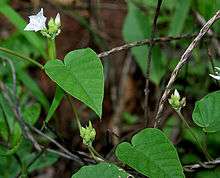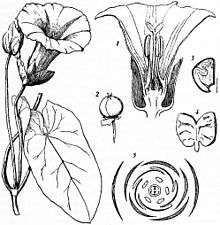Convolvulaceae
Convolvulaceae (US: /kənvɒlvjʊˌleɪsieɪ/), known commonly as the bindweed or morning glory family, is a family of about 60 genera and more than 1,650 species of mostly herbaceous vines, but also trees, shrubs and herbs, and also including the sweet potato and a few other food tubers.
| Bindweed family | |
|---|---|
 | |
| Ipomoea imperati | |
| Scientific classification | |
| Kingdom: | Plantae |
| Clade: | Tracheophytes |
| Clade: | Angiosperms |
| Clade: | Eudicots |
| Clade: | Asterids |
| Order: | Solanales |
| Family: | Convolvulaceae Juss. |
| Type genus | |
| Convolvulus | |
| Genera | |
|
See text | |

Description
Convolvulaceae can be recognized by their funnel-shaped, radially symmetrical corolla; the floral formula for the family has five sepals, five fused petals, five epipetalous stamens (stamens fused to the petals), and a two-part syncarpous and superior gynoecium. The stems of these plants are usually winding, hence their Latin name (from convolvere, "to wind"). The leaves are simple and alternate, without stipules. In parasitic Cuscuta they are reduced to scales. The fruit can be a capsule, berry, or nut, all containing only two seeds per one locule (one ovule/ovary).

The leaves and starchy, tuberous roots of some species are used as foodstuffs (e.g. sweet potato and water spinach), and the seeds are exploited for their medicinal value as purgatives. Some species contain ergoline alkaloids that are likely responsible for the use of these species as ingredients in psychedelic drugs (e.g. ololiuhqui). The presence of ergolines in some species of this family is due to infection by fungi related to the ergot fungi of the genus Claviceps. A recent study of Convolvulaceae species, Ipomoea asarifolia, and its associated fungi showed the presence of a fungus, identified by DNA sequencing of 18s and ITS ribosomal DNA and phylogenetic analysis to be closely related to fungi in the family Clavicipitaceae, was always associated with the presence of ergoline alkaloids in the plant. The identified fungus appears to be a seed-transmitted, obligate biotroph growing epiphytically on its host.[1] This finding strongly suggests the unique presence of ergoline alkaloids in some species of the family Convolvulaceae is due to symbiosis with clavicipitaceous fungi. Moreover, another group of compounds, loline alkaloids, commonly produced by some members of the clavicipitaceous fungi (genus Neotyphodium), has been identified in a convolvulaceous species, but the origin of the loline alkaloids in this species is unknown.[2]
Members of the family are well known as showy garden plants (e.g. morning glory) and as troublesome weeds (e.g. bindweed and dodder), while Humbertia madagascariensis is a medium-sized tree. Some parasitic members of this family are also used medicinally.[3]
Genera
- Tribe Aniseieae
- Aniseia Choisy
- Odonellia K.R.Robertson
- Tetralocularia O'Donell[4]
- Tribe Cardiochlamyeae
- Cardiochlamys Oliv.
- Cordisepalum Verdc.
- Dinetus Buch.-Ham. ex Sweet
- Duperreya Gaudich.
- Poranopsis Roberty
- Tridynamia Gagnep.[5]
- Tribe Convolvuleae
- Calystegia R.Br. – Bindweed, morning glory
- Convolvulus L. – bindweed, morning glory
- Jacquemontia Choisy
- Polymeria R.Br.[6]
- Tribe Cresseae
- Bonamia Thouars
- Cladostigma Radlk.
- Cressa L.
- Evolvulus L.
- Hildebrandtia Vatke
- Seddera Hochst.
- Stylisma Raf.
- Wilsonia R. Br.[7]
- Tribe Cuscuteae
- Tribe Dichondreae
- Tribe Erycibeae
- Ericybe Roxb.[10]
- Tribe Humbertieae
- Humbertia [11]
- Tribe Ipomoeeae
- Argyreia Lour. – Hawaiian baby woodrose
- Astripomoea A.Meeuse
- Blinkworthia Choisy
- Ipomoea L. – morning glory, sweet potato
- Lepistemon Blume
- Lepistemonopsis Dammer
- Paralepistemon Lejoly & Lisowski
- Rivea Choisy
- Stictocardia Hallier f.[12]
- Tribe Maripeae
- Dicranostyles Benth.
- Itzaea Standl. & Steyerm.
- Lysiostyles Benth.
- Maripa Aubl.[13]
- Tribe Poraneae
- Calycobolus Willd. ex Schult.
- Dipteropeltis Hallier f.
- Metaporana N.E.Br.
- Neuropeltis Wall.
- Neuropeltopsis Ooststr.
- Porana Burm.f.
- Rapona Baill.
- Camonea Raf.
- Daustinia Buril & Simões
- Decalobanthus Ooststr.
- Distimake Raf.
- Hewittia Wight & Arn.
- Hyalocystis Hallier f.
- Keraunea Cheek & Sim.-Bianch.
- Merremia Dennst. ex Endl. – Hawaiian woodrose
- Operculina Silva Manso
- Remirema Kerr
- Xenostegia D.F.Austin & Staples<ref>
References
- Ulrike Steiner; Mahalia A. Ahimsa-Müller; Anne Markert; Sabine Kucht; Julia Groß; Nicole Kauf; Monika Kuzma; Monika Zych; Marc Lamshöft; Miroslawa Furmanowa; et al. (2006). "Molecular characterization of a seed transmitted clavicipitaceous fungus occurring on dicotyledoneous plants (Convolvulaceae)". Planta. 224 (3): 533–544. doi:10.1007/s00425-006-0241-0. PMID 16525783.
- Britta Tofern; Macki Kaloga; Ludger Witte; Thomas Hartmann; Eckart Eich (1999). "Occurrence of loline alkaloids in Argyreia mollis (Convolvulaceae)". Phytochemistry. 51 (8): 1177–1180. doi:10.1016/S0031-9422(99)00121-1.
- O'Neill, A.R.; Rana, S.K. (2019). "An ethnobotanical analysis of parasitic plants (Parijibi) in the Nepal Himalaya". Journal of Ethnobiology and Ethnomedicine. 12 (14). doi:10.1186/s13002-016-0086-y.
- "Genera of Convolvulaceae tribe Aniseieae". Germplasm Resources Information Network. United States Department of Agriculture. Archived from the original on 2015-09-24. Retrieved 2009-04-13.
- "Genera of Convolvulaceae tribe Cardiochlamyeae". Germplasm Resources Information Network. United States Department of Agriculture. Archived from the original on 2015-09-24. Retrieved 2009-04-13.
- "Genera of Convolvulaceae tribe Convolvuleae". Germplasm Resources Information Network. United States Department of Agriculture. Archived from the original on 2015-09-24. Retrieved 2009-04-13.
- "Genera of Convolvulaceae tribe Cresseae". Germplasm Resources Information Network. United States Department of Agriculture. Archived from the original on 2015-09-24. Retrieved 2009-04-13.
- "Genera of Convolvulaceae tribe Cuscuteae". Germplasm Resources Information Network. United States Department of Agriculture. Archived from the original on 2015-09-24. Retrieved 2009-04-13.
- "Genera of Convolvulaceae tribe Dichondreae". Germplasm Resources Information Network. United States Department of Agriculture. Archived from the original on 2015-09-24. Retrieved 2009-04-13.
- "Genera of Convolvulaceae tribe Erycibeae". Germplasm Resources Information Network. United States Department of Agriculture. Archived from the original on 2015-09-24. Retrieved 2009-04-13.
- "Genera of Convolvulaceae tribe Humbertieae". Germplasm Resources Information Network. United States Department of Agriculture. Archived from the original on 2015-09-24. Retrieved 2009-04-13.
- "Genera of Convolvulaceae tribe Ipomoeeae". Germplasm Resources Information Network. United States Department of Agriculture. Archived from the original on 2015-09-24. Retrieved 2009-04-13.
- "Genera of Convolvulaceae tribe Maripeae". Germplasm Resources Information Network. United States Department of Agriculture. Archived from the original on 2015-09-24. Retrieved 2009-04-13.
- Simões, A. R.; Staples, G. (2017-04-01). "Dissolution of Convolvulaceae tribe Merremieae and a new classification of the constituent genera". Botanical Journal of the Linnean Society. 183 (4): 561–586. doi:10.1093/botlinnean/box007. ISSN 0024-4074.
Further reading
- Daniel F. Austin (1973). "The American Erycibeae (Convolvulaceae): Maripa, Dicranostyles, and Lysiostyles I. Systematics". Annals of the Missouri Botanical Garden. 60: 306–412. JSTOR 2395089.
- Austin, D. F. 1997. Convolvulaceae (Morning Glory Family)
- Convolvulus plant
- Convolvulaceae in L. Watson and M. J. Dallwitz (1992 onwards). The families of flowering plants.
- Daniel F. Austin (2000). "Bindweed (Convolvulus arvensis, Convolvulaceae) in North America – from medicine to menace". Journal of the Torrey Botanical Society. 127 (2): 172–177. JSTOR 3088694.
- Costea, M. 2007-onwards. Digital Atlas of Cuscuta (Convolvulaceae)
- Lyons, K. E. 2001. Element stewardship abstract for Convolvulus arvensis L. field bindweed. The Nature Conservancy.
- Calif. Dept. of Food and Agriculture. Undated. Field bindweed (Convolvulus arvensis L.)
- Univ. of Idaho Extension. 1999. Homewise: No matter what we do, our morning glory weeds come back every year. Any advice? Aug. 23
- Hodges, L. 2003. Bindweed identification and control options for organic production. NebFacts. Univ. of Nebraska – Lincoln Cooperative Extension
- Univ. of California Agriculture and Natural Resources. 2003. Field Bindweed. Pest Notes. Publ. # 7462
- Washington State Univ. Cooperative Extension. Undated. Hortsense: Weeds: Field bindweed (Wild morningglory): Convolvulus arvensis
- Sullivan, P. 2004. Field bindweed control alternatives. ATTRA. National Sustainable Agriculture Information Service.
- Lanini, W. T. Undated. Organic weed management in vineyards. University of California, Davis Cooperative Extension.
- Cox, H. R. 1915. The eradication of bindweed or wild morning-glory. U.S. Dept. of Agriculture Farmers’ Bulletin 368. Washington, D. C.: Government Printing Office.
- J. L. Littlefield (2004). "Bindweeds". In Eric M. Coombs (ed.). Biological Control of Invasive Plants in the United States. Corvallis OR: Oregon State University Press. pp. 150–157. ISBN 978-0-87071-029-2.
- New Mexico State Univ. Cooperative Extension Service. 2004. Managing Aceria malherbae gall mites for control of field bindweed.
- Sue Dockstader (2005). "Coping with field bindweed without using herbicides". Journal of Pesticide Reform. 25 (1): 6–7. Archived from the original on 2012-04-22. Retrieved 2012-02-14.
External links
| Wikimedia Commons has media related to Convolvulaceae. |
| Wikispecies has information related to Convolvulaceae |
- Convolvulaceae Unlimited
- Convolvulaceae in Topwalks
- Family Convolvulaceae Flowers in Israel